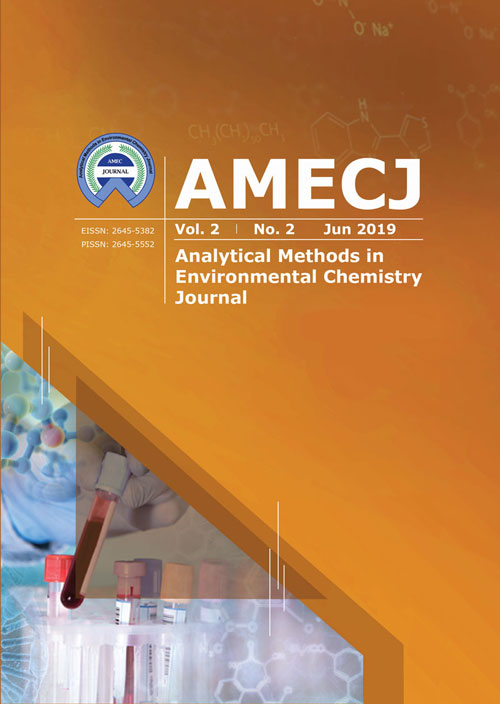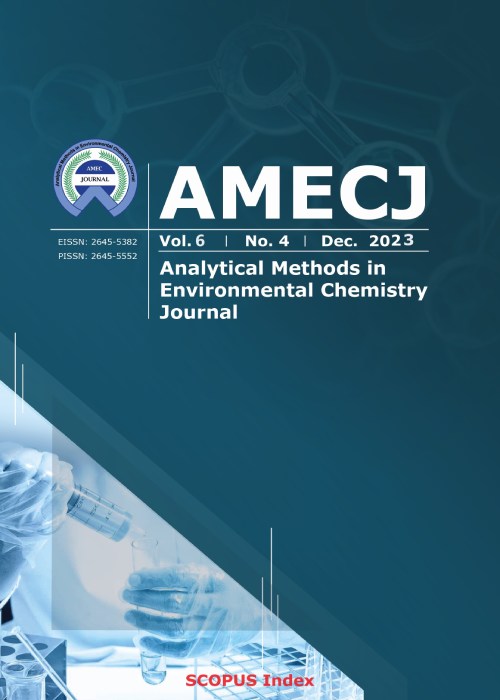فهرست مطالب

Analytical Methods in Environmental Chemistry Journal
Volume:2 Issue: 2, Jun 2019
- تاریخ انتشار: 1398/05/19
- تعداد عناوین: 7
-
Pages 5-12The chitosan nanocomposites were rapidly prepared by simple solution method. This biopolymer matrix was modified by prepared nanoscale silver (Ag) using in situ synthesis from precursor and nanomontmorillonite (NMMT). The samples were characterized by Fourier transform infrared (FTIR) spectroscopy, thermogravimetric analysis (TGA), field emission scanning electron microscopy (FESEM), and energy dispersive x-ray spectroscopy (EDX). The water vapor properties (WVP) of nanocomposites were investigated using gravimetric standard. The antibacterial activity of nanocomposite was measured by the well diffusion method on Muller–Hinton Agar against Escherichia coli (E. coli) by zone inhibition. Based on the obtained results, the nanocomposite can have a good candidate for different applications and food packaging industry.Keywords: Nanocomposite, Chitosan, Nanoscale silver, Nanomontmorillonite, Packaging
-
Pages 13-30Microplastics are ubiquitous tiny plastic particles (< 5 mm) nonbiodegradable and have large surface area in the environment or the body of living things from anthropogenic activities or fragmentation of plastic debris. Though found in sea food and human body, their health implications are still speculative. A major reason for dearth of information on this topical issue is the lack of standard methods for analyzing microplastics in more complex environmental matrices. In the present review some methodologies for analyzing microplastics reported in the period 2000 to 2018 have been documented with the aim of assessing which methods is most suitable and in what matrix. The following methods have been studied: CHN analyzers, pyrolysis-gas chromatography/mass spectroscopy (PyrGC/MS), optical microscopy, fourier transform infrared microspectroscopy (Micro-FTIR), raman microspectroscopy (RMS) and scanning electron microscopy with energy dispersive x-ray spectroscopy (SEM-EDS). Studies have been conducted with often a combination of two methods; one separating and the other quantifying which can be problematic moreso in living tissue where there is no harm reported as at the time of this study. However, microplastics have become a cause for concern and advance studies are required to unravel the potential risk of their presence in our food and environment.Keywords: Anthropogenic, Fragmentation, Health implications, Hyphenated methods, Matrices, Seafood
-
Pages 31-36In this paper we tried to improve the adsorption amount by adding graphene/CNT hybrid in the structure of Activated Carbon (AC) for removing manganese ions from aqueous solutions. The bonding of G/CNT hybrid with activated carbon creates a structure that is an excellent absorbent for removing some heavy metal ions. So the Performance increasing of ion adsorption was compared with AC results as the blank adsorbent. The influence of time, pH solution, initial concentration of Mn2+ and temperature investigated as experimental conditions. The maximum adsorption was 89.38% and 96.18% for AC and AC/G/CNT composite respectively at 30 min, initial concentration of 30 mg/L, pH=4.5 in 15°C for both adsorbents. The results showed that under the same conditions, the presence of G/CNT hybrid in the structure of AC increased the amount of adsorption by 7.5%Keywords: Adsorption, Manganese, Activated Carbon, graphene, CNT, hybrid
-
Pages 37-44Determination of hydrogen sulfide, (H2S) in crude oil is very important due to the environmental impacts, industrial problems and legal international limitation of transportation. In the present work, H2S of crude oil is determined by liquid-liquid extraction followed by potentiometric titration. Three factors including dilution ratio of crude oil with toluene, extraction time of H2S into the caustic phase and API of crude oil was investigated via factorial design. The ANOVA results revealed that the dilution ratio, crude type and extraction time have the highest effect of the recovery of H2S from crude oil. The linear dynamic range of the method was from 1 up to 2000 ppm which can be manipulated for lower or higher concentration by further optimization of the above-mentioned parameters. This method is rapid, reliable, operator-independent which make it a useful technique for the field test of crude oil and overcome extreme uncertainty of H2S measurement.Keywords: Crude Oil, Determination, Hydrogen Sulfide, Experimental Design, Field test
-
Pages 45-54A new synthesized sorbent based on functionalizing graphene with N-Phenyl-3-aminopropyl trimethoxy silane (G-PhAPTMS, C12H21NO3Si), was developed as a novel sorbent for removal of toluene from air by sorbent gas extraction procedure (SGEP). By proposed method, the removal efficiency of G-PhAPTMS was compared with other sorbents such as activated carbon (AC), graphene (G) and graphene oxide (GO). The standard gas of toluene generated in pure air with different concentrations and the effects of parameters such as temperature (10-90 °C), flow rate (50-500 mL min-1) and the amount of sorbent (2-30 mg) were investigated. According to the results, increasing the flow rate and temperature had negative effects on the removal efficiency of all sorbents. The highest removal efficiency of G-PhAPTMS was obtained up to 35 °C and less than 250 mL min-1 (>95%). In optimized conditions, the amount of sorbent for toluene removal was achieved more than 10 mg of G-PhAPTMS.Keywords: Toluene, Chemical adsorption, Graphene, N-Phenyl-3-aminopropyl trimethoxy silane, Sorbent gas extraction procedure
-
Pages 55-64A novel task-specific ionic liquid (TSILs) was used for highly sensitive extraction and separation of nickel and cadmium in olive oil by thermal ultrasound-assisted dispersive multiphasic microextraction (TUSA-DMPμE). By proposed method, a mixture containing of hydrophilic TSILs (α- Cyano-4-hydroxycinnamic acid diethylamine; [CHCA] [DEA] and 1-(2-Hydroxyethyl)-3-methylimidazolium tetrafluoroborate; [HEMIM][BF4]) as a complexing and extracting solvent, acetone as a dispersant of TSILs was added to diluted olive oil with n-hexane containing Cd (II) and Ni (II) that was already complexed by TSILs in 60OC at pH 6.0-7.5. After optimized conditions, the enrichment factor (EF), Linear range (LR) and limit of detection (LOD) were obtained (19.3; 19.6), (5.0- 415 μg L-1; 2.7- 92 μg L-1) and (1.3 μg L-1; 0.6 μg L-1) with [CHCA] [DEA] and (13.7; 14.2), (7.5- 600 μg L-1; 3.6- 128 μg L-1) and (2.2 ng L-1; 0.9 μg L-1) with [HEMIM][BF4] for Ni and Cd ions in olive samples respectively.Keywords: Olive oil, Cadmium, nicke, Thermal ultrasound-assisted dispersive multiphasic microextraction, Task specific ionic liquid, Atom trap flame atomic absorption spectrometry
-
Pages 65-76This study investigates an application of zinc metalloporphyrin grafted Fe3O4 nanoparticles as a new adsorbent for removal of sulfate ions from wastewaters. The modification of magnetite nanoparticles was conducted by 3-aminopropyltriethoxysilane followed by zinc (II) porphyrin in order to enhance the removal of sulfate ions. Fourier Transform Infrared Spectroscopy (FT-IR), X-ray diffraction (XRD), Transmission Electron Microscopy (TEM) and Scanning Electron Microscopy (SEM) was used to characterize the synthesized nano sorbent. The effect of important experimental factors such as pH, contact time, sorbent dosage and some co-existing anions present in aqueous solutions were investigated. Under optimal conditions (i.e. contact time: 30 min, pH: 6.5 and nanosorbents dosage: 100 mg) for a sulfate sample (50 mL, 50 mgL-1 ) the percentage of the extracted sulfate ions was 94.5%. Regeneration of sulfate adsorbed material could be possible by NaOH solution and the modified magnetic nano sorbent exhibited good reusability.Keywords: Magnetic nanoparticles, water samples, Sulfate removal, Zinc (II) porphyrin, Nanosorbent


